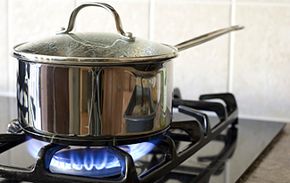The electric vs. gas stove debate is always spirited. But, when you're whipping up your famous beef Bourguignon or paella, the thought of saving money and energy costs probably isn't at the front of your mind. Yet you could be saving money every single time you cook these recipes--or any other dish--if you have an energy-efficient stove.
You may have comparison shopped browsed the least expensive electric models at your local appliance store, but looking at the purchase price alone won’t tell you how much you'll end up paying in the long run.
Advertisement
Both gas and electric ranges fall into a similar price range, depending on the brand and model. Generally, you'll spend $650 to $2,800 for an electric stove, and $800 to $2,300 for a gas stove, according to Consumer Reports. If you buy a lower-end electric stove, you may save money upfront, but the costs of operating that stove will start to add up the more you cook.
According to the California Energy Commission, most Americans currently cook on an electric stove, and they may not be taking advantage of the greatest energy savings. Click on the next page to learn why switching to gas could save you money on your annual energy bills.
Advertisement
